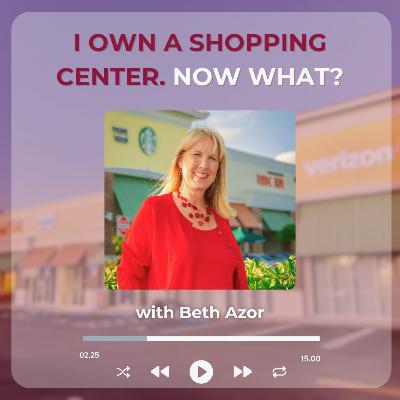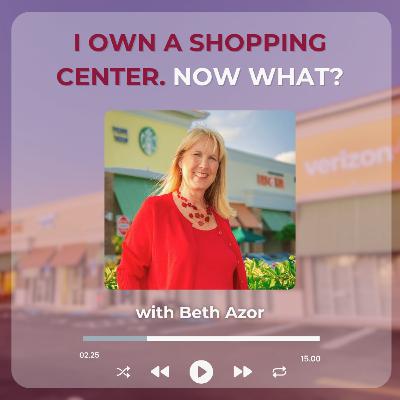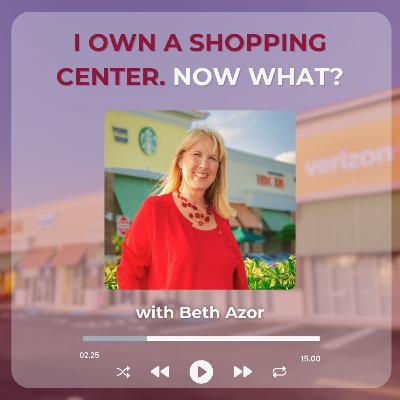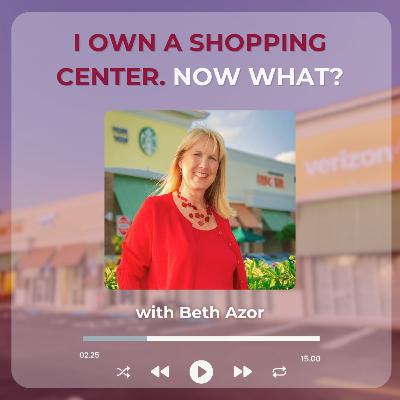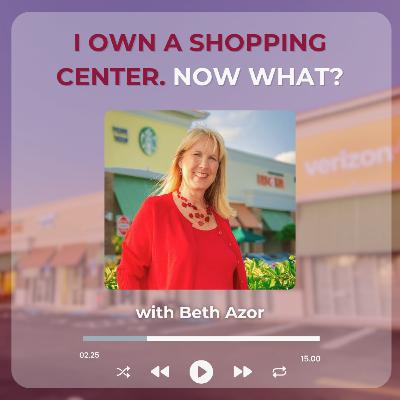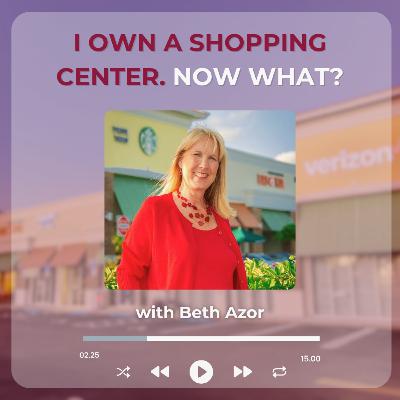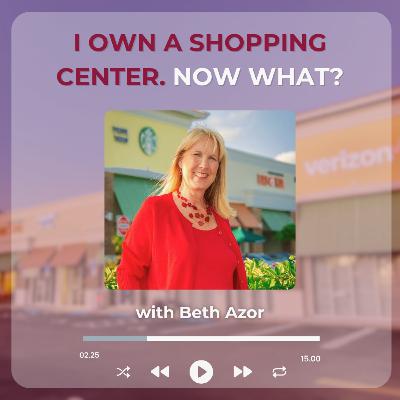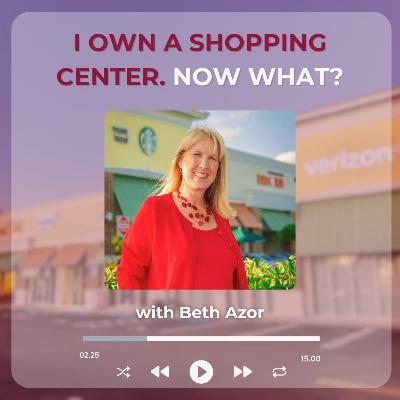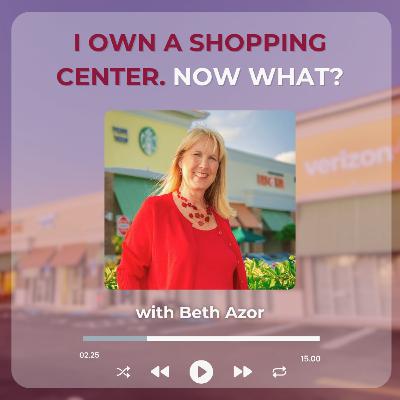Discover Beth Azor
Beth Azor

Beth Azor
Author: Beth Azor
Subscribed: 31Played: 708Subscribe
Share
© Beth Azor
Description
Welcome to Beth Azor's Podcast Channel featuring "The Retail Leasing Playbook Podcast" & "I Own a Shopping Center, Now What?" your ultimate guide to mastering retail leasing and maximizing your commercial real estate potential, hosted by the renowned "Canvassing Queen™," Beth Azor.
Both podcasts have practical advice, insider tips, and proven techniques for boosting leasing performance and achieving financial goals. Beth will guide you in a Cliff's Notes Version" chapter by chapter of her book, The Retail Leasing Playbook.
Join Beth and her guests to improve your retail leasing game today!
Both podcasts have practical advice, insider tips, and proven techniques for boosting leasing performance and achieving financial goals. Beth will guide you in a Cliff's Notes Version" chapter by chapter of her book, The Retail Leasing Playbook.
Join Beth and her guests to improve your retail leasing game today!
266 Episodes
Reverse
EV chargers are popping up in shopping centers everywhere, promising “free” money through ancillary income deals—but I say: not so fast. In this episode, I break down the hidden risks of adding EV charging stations, especially when it comes to parking ratios and long-term tenant satisfaction.I explain why I haven’t jumped on the EV charger bandwagon just yet, including the potential loss of valuable parking spaces and the unintended consequences it could have on restaurant tenants and customer traffic. If you're considering installing EV chargers at your property, this episode might change your approach.Key Insights:✔️ EV charger companies often provide free equipment—but at the cost of parking spaces✔️ Losing key parking can negatively affect restaurants and high-traffic tenants✔️ Ancillary income is great, but not if it reduces your overall leasing potential✔️ Every parking decision should factor into your site’s overall tenant mix and traffic flow✔️ What looks like “free money” could cost you in NOI down the line
Struggling to lease your retail space in a multifamily project? You might be making this common mistake.In Episode 65 of I Own a Shopping Center. Now What?, I share a recent conversation I had with some multifamily investors who were venturing into retail for the first time. Leasing retail—especially on the ground floor of high-rise projects—is a whole different animal, and getting it right starts with hiring the right third-party team.I walk you through exactly how I advised them: how many firms to interview, what expectations to put in writing, and why it's critical to know the market even better than the broker you hire. I also break down why it’s okay—and necessary—to fire leasing agents who aren’t performing. If you’re going to delegate, you still have to manage smartly.🔑 Key TakeawaysUnderstand the default and remedy clauses in your leasesEvaluate tenant term lengths and credit strengthConfirm restrictions through in-person intelWeigh the upside of breaking outdated lease clausesKnow your waiver options—some clauses are flexibleOld leases aren’t always built for modern tenantsStrategic defaults require informed decision-makingInvite a woman to my summit—let’s grow this community!
It’s budget season—and here’s exactly how I build shopping center budgets from scratch.In Episode 65 of “I Own a Shopping Center. Now What?”, I take you behind the scenes of my step-by-step budgeting process. If you’re an owner preparing budgets between September and October, this episode is for you. I’ll show you how I forecast expenses using actuals, estimate income from leasing activity, and plan ahead for those “surprise” costs like security or vacancies.I break down how to handle vendor increases, project leasing income, and when it’s smart to loop in partners. I also share strategies to help you impress your institutional clients during budget season. And—don’t miss my special invitation to the Women’s Real Estate Investment Summit!Key Takeaways:Use actuals from the first 8–9 months to build your budgetSpread recurring costs (like landscaping) evenly across 12 monthsEstimate real estate taxes using current TRIM notices plus 10%Don’t prompt vendors for increases—budget a standard 10% bumpAccount for vacancies and utilities based on lease-up expectationsInclude leasing income and TIs with detailed assumptionsFinalize budgets before Thanksgiving, allowing 6–8 weeks to completeSend drafts to key partners for feedback if neededUnexpected expenses (e.g., security) should be noted in reportsRemember: institutions often consider switching third-party firms post-budget seasonBECOME A COMMERCIAL REAL ESTATE ROCKSTAR: https://www.bethazor.com/https://www.azoracademy.com/For more commercial real estate training: https://www.bethazor.com/training/FOLLOW ME ON SOCIALFacebook: https://www.facebook.com/azoradvisoryservices/Twitter: https://twitter.com/bethazor1Instagram: https://www.instagram.com/bethazor/Linkedin: https://www.linkedin.com/company/6315636/#retailleasing #commercialrealestateinvesting #retailleasingcoach #bethazor
What if you could train your leasing team without spending thousands on a coach?In Episode 64 of I Own a Shopping Center. Now What?, Beth Azor shares a powerful, low-cost strategy for improving leasing team performance—using her Retail Leasing Playbook Podcast. While attending ICSC Orlando, Beth spoke with a listener who wanted her to train his team, but she recommended a free, scalable alternative: assigning her podcast as weekly “homework.”Beth walks through how leasing directors can use the podcast to upskill their teams week by week. She explains how this method can spark higher leasing activity, boost rental rates, and increase property value—all without needing to fly her in.Beth also promotes her Women’s Real Estate Investment Summit, encouraging the male-heavy audience to send the women in their lives. With 250+ attendees from multiple asset classes, it’s a prime networking and educational event for female investors.✅ Key Takeaways-Use the Retail Leasing Playbook Podcast as free training for your leasing team-Assign two chapters per week and discuss takeaways in weekly meetings-Implementing this structure can increase leasing activity and rental income-Third-party brokers can benefit from this training too-You don’t need Beth in person—her content is accessible for free-92% of the podcast audience is male, but her summit empowers female investors-The Women’s Real Estate Investment Summit fosters education, networking, and joint venturesBECOME A COMMERCIAL REAL ESTATE ROCKSTAR: https://www.bethazor.com/https://www.azoracademy.com/For more commercial real estate training: https://www.bethazor.com/training/FOLLOW ME ON SOCIALFacebook: https://www.facebook.com/azoradvisoryservices/Twitter: https://twitter.com/bethazor1Instagram: https://www.instagram.com/bethazor/Linkedin: https://www.linkedin.com/company/6315636/#retailleasing #commercialrealestateinvesting #retailleasingcoach #bethazor
Syndication structures are changing—and in this episode, Beth Azor unpacks exactly how. From preferred returns and promotes to unusual LP terms and fee-loaded deals, Beth breaks down the many syndication models she’s encountered—both as an LP and a GP. She shares what she looks for before investing, the red flags that turn her off, and the structure she prefers when raising money herself. Whether you're a new sponsor or an LP eyeing your next investment, you'll walk away with tactical insight on evaluating and designing win-win syndication deals.✅ Key Takeaways:-Preferred returns vary with market conditions-Promotes typically kick in after full LP return-Sponsors should have skin in the game-Some are raising without preferred returns or promotes-Fee-heavy structures are common—but not always justifiedLPs want transparency, alignment, and realistic projections-Creatively structured deals can benefit all parties-Fundraising speed often reflects investor trust.BECOME A COMMERCIAL REAL ESTATE ROCKSTAR: https://www.bethazor.com/https://www.azoracademy.com/For more commercial real estate training: https://www.bethazor.com/training/FOLLOW ME ON SOCIALFacebook: https://www.facebook.com/azoradvisoryservices/Twitter: https://twitter.com/bethazor1Instagram: https://www.instagram.com/bethazor/Linkedin: https://www.linkedin.com/company/6315636/#retailleasing #commercialrealestateinvesting #retailleasingcoach #bethazor
Imagine buying my first shopping center for $3.5M… and letting $1M in potential value sit vacant. That’s exactly what happened—and it took a no-fluff wake-up call from Beth Azor to make me see the truth every investor needs to hear.In this episode, I unpack my conversation with a doctor-turned-investor who bought a 10-tenant retail property but is frustrated by two vacancies. Despite keeping the seller’s leasing team, nothing’s getting filled—and here’s the kicker: I haven’t even visited the market. Beth walks me through how that hands-off approach is costing me big, both in annual rent and in property value.This episode is a powerful case study in the cost of inaction—and what it really takes to build a successful portfolio of shopping centers.👉 Plus: I give a special shoutout to the Women’s Real Estate Investment Summit and share how men can support the women in their lives to invest in commercial real estate too.🔑 Key TakeawaysVacancies cost more than you think. Two empty units could mean $1M in unrealized value—know your numbers.You can’t manage what you don’t understand. If you’ve never visited the property, how do you know what’s really going on?Leasing agents aren’t miracle workers. If they’re not performing, replace them—especially before giving them renewal business.Understand your market firsthand. Rents might be $40 PSF today—not $30 like 3 years ago. Are your leasing assumptions outdated?Absentee ownership isn’t passive—it’s risky. If you want to scale, you need to be proactive or bring in the right partners.Set systems, not silos. Build relationships with tenant reps, vendors, and your tenants—even if it’s just a 3-day visit.
In this episode, I share a compelling story about how collecting tenant sales data helped me identify a struggling franchise tenant—and how one smart hiring decision turned that failing store into a top performer. I emphasize the importance of staying proactive with your tenants, even if you’re not managing a local property, and why absentee ownership can be a serious red flag.From spotting red flags to celebrating a turnaround, this episode highlights the power of involvement, holding tenants accountable, and simply paying attention to what’s happening on-site.🔑 Key Takeaways:✔️ I always collect sales data from my tenants—it alerts me to problems early.✔️ I’ve noticed that absentee franchise owners often underperform compared to hands-on operators.✔️ A single great hire can dramatically improve customer experience and store performance.✔️ I believe in being proactive and vocal when I notice tenant issues—staying silent doesn’t help.✔️ Visual merchandising and strong tenant visibility drive foot traffic and boost sales.✔️ I don’t reduce rent as a quick fix—I push for operational improvements instead.✔️ Even when I manage from afar, I monitor performance and intervene strategically.
In this episode, I share a wild (and very real) lesson on tortious interference - what it means, how I got sued for it, and what every landlord should understand when it comes to transferring leases. From NFL players selling overpriced smoothie shops to doctors trying their hand at burger franchises, I’ve seen my share of risky lease assignments - and learned to trust my instincts.I walk through two real-life examples where I blocked lease transfers, faced legal threats, and ultimately protected my shopping centers. I also explain how I secured personal guarantees, maintained leverage, and stayed paid when things went sideways. For any landlord who’s ever second-guessed their judgment or felt pressured into approving a shaky deal, this episode is essential listening.Key Insights:✔️ Tortious interference claims can surface - even when protecting the asset✔️ Lease assignment red flags are worth paying attention to✔️ Personal guarantees offer critical protection from unqualified tenants✔️ Tenants often return admitting they should have followed advice✔️ Backup tenants and strong lease terms can protect the landlord’s position✔️ Sometimes, saying “no” is the most responsible thing a landlord can do
After 30+ years in the business, it takes a lot to surprise me—but this lease clause did just that. In this episode, I share the unique situation that forced me to rethink how I approach use clauses. A tenant with a one-of-a-kind concept insisted on “any lawful retail use” as a condition of the lease. My initial reaction? No way. But what followed was a negotiation that pushed both sides to get creative.I walk through the four protections I added—including noxious use exclusions, existing tenant conflict language, and even a recapture clause—all while preserving the deal and protecting my asset. If you’ve ever dealt with an assignment clause that felt like a landmine, or a tenant who had no potential assignee, this episode will give you a new playbook.Key Insights:✔️ Narrow use clauses protect your center—but sometimes, compromise is required✔️ “Any lawful use” isn’t always risky—if structured carefully✔️ Noxious use exclusions help future-proof your lease against shifting laws✔️ Active negotiations and LOIs should also block conflicting assignments✔️ A recapture clause gives landlords control in grey areas✔️ Early negotiation (at LOI stage) helps avoid legal standoffs later
Should you be posting rental rates on sites like Crexi or LoopNet? In this episode, I explain why I don’t—and why you shouldn’t either. A Facebook post from a frustrated agent sparked this conversation, but it revealed a much bigger issue: in retail real estate, rent is never one-size-fits-all.I walk through exactly how I price space in my shopping centers, from tenant type to visibility to square footage and even lease term. I also share a story about a client who was charging the same rate—$23 PSF—across every property, including a second-story office and a Publix-anchored outparcel. Spoiler: We fixed that, fast. If you're looking to maximize NOI and get strategic about rent setting, this episode breaks down how to think like a pro.Key Insights:✔️ Rent should vary by tenant use, size, visibility, and lease term✔️ One flat rate across all units can dramatically limit your upside✔️ You can and should charge more for endcaps and high-traffic locations✔️ Don’t let online listings lock you into underpriced deals✔️ Educate your leasing agents on rent flexibility✔️ Strategic rent setting = long-term NOI growth
What happens when you’ve got a perfectly good vacancy—but exclusives are tying your hands? In this episode, I walk through one of my current leasing challenges: a second-gen restaurant space that should be a no-brainer to fill... except I’m bound by a long list of tenant exclusives. From chicken and bubble tea to even Middle Eastern food—I’m locked out of nearly every popular restaurant category.But here’s the truth: exclusives are common, and they don’t have to stall your leasing. I share the real-world strategies I use to work around them—like how I got a Latin restaurant in under a chicken-exclusive, and when it might actually make sense to challenge or negotiate a waiver. I also break down creative site planning tactics that can open doors to entirely new tenant types. If you’ve ever been stuck with a “hard-to-lease” space, this one’s for you.Key Insights:✔️ Exclusives are everywhere—but they’re not deal-breakers✔️ Strategic tenant outreach starts with knowing your approved categories✔️ Get creative with space planning to unlock better tenant matches✔️ Know the penalties for breaking exclusives—it might be worth it✔️ Waivers are possible—but often come with negotiation✔️ Encourage leasing agents to explore unexpected tenant formats
What do you do when a great property refuses to lease up—despite all your best strategies? In this episode, I share the full story of one of the toughest assets in my portfolio: a 24,000 SF strip center right across from Sawgrass Mills Mall that should’ve been a slam dunk. But thanks to poor visibility from outparcels, it sat at 60% occupancy for years. I tried everything—canvassing, broker incentives, Facebook ads, even a party. Nothing worked.Eventually, I swallowed my pride, hired a third-party broker, and together we came up with something bold: offer one year of free rent—no TI, full guarantees, no gimmicks. That single shift caught tenants’ attention and changed everything. We fully leased the center in five months and ended up selling it shortly after. If you're feeling stuck with your leasing strategy, this episode is the permission you need to shake things up.Key Insights:✔️ Even experienced owners sometimes need outside help✔️ Lack of visibility can kill demand—no matter how strong the market✔️ One year of free rent (with no TI) can still create a win-win✔️ Pressure with urgency—“clock starts in January” drove action✔️ Creativity and humility matter as much as hustle✔️ When leasing stalls, shake up the system and brainstorm hardIf you're feeling stuck on a tough leasing deal, this episode is proof that sometimes the best move is the bold one. Don’t be afraid to pivot. Your next lease might just need a different play.
Buying a shopping center off-market? It’s not fast. It’s not easy. But if you play the long game—it can be wildly profitable. In this episode, I reveal how she secured multiple off-market deals by doing what most investors won’t: cultivating relationships for years.From befriending a 76-year-old owner (who eventually made her his 50/50 GP partner!) to pulling off a seller-financed deal in under 30 days, I share the behind-the-scenes stories of mu best acquisitions—and exactly how I made them happen. I also explain how one coaching client turned an outperforming asset into a portfolio expansion using the “knock-on-doors” method.If you’re tired of getting beat out on listed deals or just want better returns, this episode is your roadmap to relationship-based acquisitions that actually work.Key Insights:✔️ Off-market deals take patience—but can deliver incredible upside✔️ Add value early—before an owner is ready to sell✔️ Seller financing is possible—even on a tight timeline✔️ Managing and leasing for free can be a strategic foot in the door✔️ Use overperforming assets as a launchpad to buy nearby centers✔️ Don’t wait for deals to be listed—make the first moveWhether you're a long-term investor or just breaking into CRE, this episode will challenge how you think about deal sourcing. The best opportunities aren’t on LoopNet—they’re hiding in plain sight.
Ever wonder what your leasing broker is really dealing with behind the scenes? In this episode, I give shopping center owners a brutally honest breakdown of what it’s like to be a retail leasing broker - from commission-only paychecks to years of hustling without listings or income. If you're considering hiring a broker (or trying to figure out why yours isn’t delivering), this is a must-listen.I share the hidden realities of training, hunger, experience, and how to spot the difference between a hustler and someone just riding the title. Whether you’re managing a broker or deciding whether your nephew should give it a go, this episode helps you make smarter decisions and set more realistic expectations.Key Insights:✔️ Most commercial leasing brokers start commission-only and need a second job to survive.✔️ Newbies rarely get proper training—owners should ask how they learned the business.✔️ A broker’s “hunger” is often shaped by their early hustle, not their title.✔️ Big brokerage firms don’t always train or assign listings to juniors.✔️ Rockstars with 30+ listings probably aren’t cold calling for your 1,200 SF vacancy.✔️ Don’t assume activity—ask direct questions about canvassing and prospecting habits.
Not all strip centers are created equal - and if you're looking to buy one, you better know what to look for. In this episode, I break down the critical (and often overlooked) details that can make or break your investment.From parking ratios and restaurant tenants to visibility challenges and shifting demographics, Beth shares the exact advice she’s giving in DMs and emails to prospective buyers. I even open up about a shopping center I couldn’t lease - because of poor visibility - and what I learned the hard way.Thinking about splitting a 10,000 SF space into four bays? I get into the real costs - and why you should lease it first, then build it out. This is must-hear guidance for anyone buying or repositioning a center in today’s market.Key Insights: ✔️ Restaurants bring rent—but need the most parking ✔️ Poor visibility = long, painful vacancy battles ✔️ Traffic counts and tenant mix reveal a center’s true potential ✔️ Changing demographics can stall leasing momentum ✔️ Splitting space costs six figures—lease before you spend ✔️ Homeless issues? Temporary security can work wondersThis episode is full of tactical tips for evaluating a deal beyond the surface. If you’re serious about buying strip centers, this is your blueprint to avoid costly mistakes—and lease faster, smarter, and stronger.
We’re always told to be responsive - but can you be too responsive? In this milestone 50th episode, I share when rapid response is a superpower in leasing… and when it actually backfires. From texting prospects on planes to responding to market study calls, she outlines when responsiveness builds trust - and when it trains tenants to abuse it.I also share my policy for returning broker calls, handling problem tenants, and even paying vendors fast to earn loyalty. But for those few tenants who call every day with non-issues? I explain exactly why not calling back immediately is the right move.Key Insights:✔️ Text-for-info signs increase lead response, even mid-flight✔️ Always return broker and vendor calls—it pays off long term✔️ Pay vendors quickly to get prioritized in return✔️ Some tenants use quick replies to demand excessive attention✔️ It's okay to delay responses to problem tenants—set boundaries✔️ Responsiveness should be strategic, not reactiveEven though responsiveness is key to great landlord-tenant relationships, knowing when to pause is just as powerful. This episode gives you permission to protect your time—and train your tenants to respect it.
Think your portfolio is too small to call national retailers? Think again. In this episode, I break down down why even small shopping center owners should reach out to national tenants directly. Whether you own one property or 50, the key is to do your homework, know what the retailer needs, and make a compelling case for why your location is the perfect fit.I share practical tips on how to get past the gatekeepers, why most landlords never visit retailer headquarters (and why you should), and how building these connections early can pay off as your portfolio grows. Don’t wait—learn how to confidently approach national retailers and set yourself apart from the crowd.Key Insights:✔️ You don’t need a huge portfolio to approach national retailers—just do your research✔️ Know the brand’s needs before you call, and offer something valuable✔️ Visit retailer headquarters whenever possible—few landlords make the effort✔️ Confidence and preparation go a long way—don’t be intimidated✔️ Start building relationships now, even if you’re a small portfolio ownerEven if you’re just starting out with a few properties, now is the time to make connections with the brands you want in your shopping center. As your portfolio grows, these relationships can give you a competitive edge and help you secure high-quality tenants down the line.If you’ve ever felt hesitant to reach out to a national retailer, this episode will give you the mindset and strategy to move forward with confidence.
Sometimes it’s the little details that make the biggest impact. In this episode, I share the small but powerful changes she’s made to lease her shopping center spaces faster. From adding "Text for Info" to her leasing signs to setting up a quasi leasing office inside vacant spaces, I explain how these simple tweaks attract more interest and create opportunities to connect with prospective tenants.I also cover practical tips like keeping utilities on to make spaces more inviting, using a single master key for all vacancies, and updating flyer images to reflect the most popular tenants. Whether you’re trying to lease a few spaces or manage a larger portfolio, these ideas will help you present your properties better and make leasing easier.Key Insights:✔️ Keep utilities on in vacant spaces—comfort and safety matter✔️ Use a single master key for easier access to all vacancies✔️ Set up a simple quasi leasing office for on-site meetings✔️ Add “Text for Info” on your leasing signs—easy for prospects✔️ Update flyer images to feature your most popular tenants✔️ Highlight infrastructure like grease traps on storefront banners
ICSC Vegas is fast approaching - but should small shopping center owners actually go? In this episode, I break down whether the biggest retail real estate event of the year is worth the cost and time for investors who own just a few properties.From networking hacks (like who you might meet in a rideshare) to what part of the event is actually valuable (hint: Professional Development Sunday), I share real talk on what you’ll get - and what you won’t - if you’re going to Vegas with a small portfolio and big expectations.Key Insights:✔️ ICSC Vegas is valuable for education and connections—but may not land you tenants✔️ Local or regional ICSC shows are far more productive for small owners✔️ If you’re going, don’t miss Professional Development Sunday✔️ Avoid marketing to national tenants unless your portfolio justifies it✔️ Use LinkedIn to pre-book meetings and avoid wandering the floor✔️ Network early: opportunities start at the airport gate and hotel lobby
Last week was all about reports - but I left one of the most important off the list: occupancy percentage. In this episode, I dive deep into how tracking tenant occupancy costs not only helps you price rent with confidence, but also helps you spot trouble early, negotiate smarter, and even defend higher valuations with lenders and buyers.I share how I’ve used this data to justify rent increases, negotiate better cap rates, and understand which tenants are performing - and which might be at risk. If you're not tracking occupancy percentages yet, this episode will make you start.Key Insights:✔️ Occupancy percentage = rent as a % of tenant sales—track it, use it✔️ Use it to price rent, negotiate renewals, and spot underperforming tenants✔️ Some tenants can handle higher % than others (e.g. liquor vs. furniture)✔️ I use occupancy ratios to justify lower cap rates in refis/sales✔️ You can start learning by analyzing OM rent rolls & reported sales✔️ Most landlords ignore this - make it your edge


